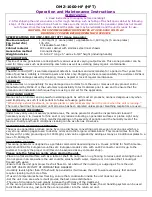
15
General Installation Guidelines
Due to our policy of continuous product innovation, some specifications may change without notification.
©LG Electronics U.S.A., Inc., Englewood Cliffs, NJ. All rights reserved. “LG” is a registered trademark of LG Corp.
GENERAL INSTALLATION GUIDELINES
Mounting Bolt Location
General Mounting
Securely attach the outdoor unit to a condenser pad, base rails, or
another mounting platform that is securely anchored to the ground
or building structure. Attach the outdoor unit with a bolt and nut on a
concrete or rigid mount. See Figure 3. Follow applicable local codes
for clearance, mounting, anchor and vibration attenuation require-
ments.
All referenced materials are to be field-supplied. Images are not to scale.
Figure 3: Outdoor Unit Mounting Methods
Bolt
Placement
& Anti-Vibration
Pad
Piping Connection
Top of Unit
Foundation
Mounting Platform
The underlying structure or foundation must be designed to support
the weight of the unit. Avoid placing the unit in a low lying area
where water may accumulate. When installing the outdoor unit on
the wall, or roof top, anchor the mounting base securely to account
for wind, earthquake or vibration.
Tie-Downs and Wind Restraints
The strength of the Duct-free Split Single Zone Inverter system
frame is adequate to be used with field-provided wind restraint tie-
downs. The overall tie-down configuration must be approved by a
local professional engineer.
Always refer to local code when designing a wind restraint system.
Snow and Ice Conditions
In climates that experience snow build-up, place the unit on a raised platform to ensure condenser airflow. The raised support platform must
be high enough to allow the unit to remain above possible snow drifts. Mount the unit on a field-provided snow stand at a minimum height
that is equal to the average annual snowfall plus 20 inches. Design the mounting base to prevent snow accumulation on the platform in front
or back of the unit case. If necessary, provide a field fabricated hood to keep snow and ice and/or drifting snow from accumulating on the coil
surfaces. Use inlet and discharge duct or hoods to prevent snow or rain from accumulating on the fan inlet and outlet guards. Best practice
prevents snow from accumulating on top of the unit. Consider tie-down requirements in case of high winds or where required by local codes.
When deciding on a location to place the outdoor unit, be sure to choose an area where run-off from defrost will not accumulate and freeze on
sidewalks or driveways.
















































